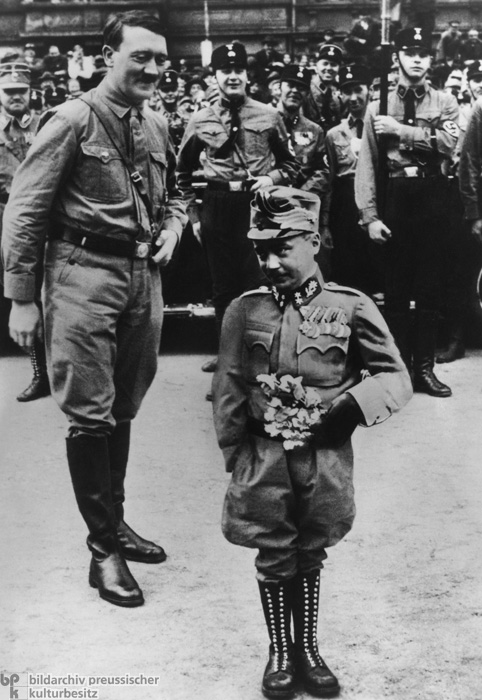













INTRODUCTION | DOCUMENTS | IMAGES | MAPS | EDITOR
|
Hitler considered the German Reich's annexation of Austria as the natural joining of the German populations of both countries. Up to 1933, most Austrian political parties had also pursued this goal, but with the appointment of Christian Social Party politician Engelbert Dollfuß as chancellor of the Austrian republic, the domestic and foreign position of the country changed drastically. By 1934, Dollfuß had deprived the National Assembly of power, suspended the parliamentary constitution, and prohibited all political parties, including the Austrian NSDAP. The constitution decreed by Dollfuß established a Fascist-corporatist state on the Italian model. In foreign policy, Dollfuß defended Austria's right to self-determination and its independence from the German Reich. Despite the prohibition on political parties, the Austrian NSDAP continued to agitate, with German support, against the Dollfuß regime. Hitler appointed the German Reichstag deputy Dr. Theo Habicht to lead Nazi underground operations. From his Munich base, Habicht helped prepare a putsch attempt against Dollfuß, which members of the Austrian NSDAP and the SS were planning for mid-1934. On July 25 of the same year, 150 members of SS-Regiment 89 [SS-Standarte 89] stormed the chancellor's office in Vienna and shot Dollfuß. However, this operation and several Nazi insurrections in the country were quickly put down by the Austrian army. For Hitler, who claimed not to be involved, the "July putsch" was a foreign policy disgrace and a temporary setback that also brought the German-Italian relationship to a low point. Mussolini, who regarded himself as the guardian of Austria’s independence and who had stationed troops on the Brenner Pass during the attempted putsch, was beside himself with rage. The tense relationship between the two dictators did not relax until after the Italian invasion of Abyssinia the following year. In return for Hitler's support, Mussolini informed him that he had no objection to Austria's becoming a German satellite state.
The postcard reproduced below circulated in Germany shortly before the assassination of Dollfuß. At 4”11, the Austrian Chancellor was undeniably small in stature. It would appear, however, that this photograph has been distorted make Dollfuß look even shorter in comparison with Hitler, who was reported to be approximately 5”8.
© Bildarchiv Preußischer Kulturbesitz |
 print version
print version return to image list
return to image list previous image
previous image
